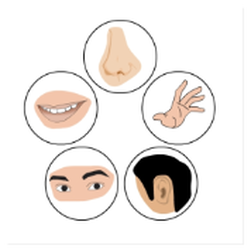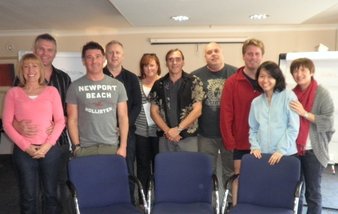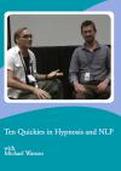This is the sixth installment in our exploration of the presuppositions of NLP. And we’ve only got a couple presuppositions left to share with you. This episode is about communication and it comes along just at the right time in our sequence. We left off last issue talking about the importance of flexibility and how success depends on it. We considered how valuable a skill it is to be able to vary our behavior … to roll with the punches … to adjust and adapt to whatever comes our way until we get what we’re going for.
And in all of our experience there is nowhere that flexibility is more important than in our communication.
Of course we’re always communicating, and we do it through multiple channels. That’s the meaning of the next of our essential attitudes:
COMMUNICATION IS REDUNDANT
If you were to become angry about something you might put on a “mad face”, and your skin may change color, and your tone of voice would likely change. Your posture might shift. Certain gestures may be generated. Perhaps there will be some foot stamping, or door slamming. The words you say are only one part of rich communications system that expresses itself in multiple channels.
This is one of the reasons that NLP really prizes sensory acuity. The ability to detect both overt and subtle signals is worth developing. Being aware of many channels at once can offer us a great deal of information that could be missed. Have you ever noticed how sometimes a person might say, “I really am happy about (whatever)” while shaking their head side to side as if to say “No”? Or smiling politely and sociably, while tapping a foot impatiently, or clenching a jaw … or a fist?
We’re always communicating something. Couples know how deafening the silent treatment can be, and how much you can say by NOT talking. Yet while we can’t NOT communicate, it’s not always a successful operation.
Part of the challenge lies in the language. We may use the same words, but they don’t mean the same thing to each of us. It’s easy to run into misunderstandings in our relationships when people use fluffy words like “loyalty”, “trust”, “love”, “support” or “faith” for instance … and they lead us to have certain expectations – based on our OWN understanding of those words – that may be quite different than the other person’s understanding. Nowhere in Webster’s Dictionary does it say that “husband” means “somebody who will put up with criticism from his mother in law” … or that “wife” is “the woman who does all of the cooking”. We all make up our own meanings. Using the same words, we each speak our own language. And it’s a miracle that we ever successfully communicate at all.
And because the words are so tenuous, we depend on inflection and gesture and expression to further convey our meaning. Perhaps you’ve had the experience of being misunderstood on the internet, or in a text message or letter because your joking tone didn’t come through. (LOL)
INTENDED MESSAGE = MESSAGE RECEIVED
Getting the point across. Understanding and being understood. That’s what successful communication is all about. And in the world where results are important, it’s the impact of the communication that matters most. The test of success is in the message received. And that’s what the next presupposition is about:
THE MEANING OF YOUR COMMUNICATION IS THE RESPONSE THAT IT GETS
Effective communication is communication that has the desired effect as shown by the response it elicits.
A teacher that I know was growing frustrated with his students one day. He said to me, “I tell them once. I’ll tell them a second time. And then if they don’t get it, that’s THEIR problem.” But in fact, it’s his problem if what he wants is to be understood.
We get an idea, we want to express it, we put it into words and we speak, our job isn’t done. It’s only just begun.
When I was a child my mother used to ask, “How many times do I have to tell you?” Knowing what I know now, I’d have to say “Just once, Mom … But could you do it more effectively?”
The communication you’re sending out is your responsibility … because it’s your agenda. And I don’t mean responsibility in the sense of blame. Perhaps, to say it another way, you’re communicating because you want to be understood, right? So the task is to make that happen.
This presupposition reminds us of the good news. You can know how well you’re doing by paying attention to the responses you’re getting.
Remember that it isn’t just the words and that you have gestures and voice tone and facial expressions and more to help you. Use them. (And notice them in others.)
Earlier we talked about the importance of flexibility and adjusting your behavior/communication until it has the effect you want. Make those adjustments … watch for responses … keep adjusting until you’ve got it. Message Received.
So what does this have to offer hypnotherapists?
This presupposition is an essential attitude for hypnotherapists. It reminds us to be guided by our client’s responses during our intake, when we’re doing inductions and throughout our sessions. We listen and speak and observe carefully. Then we use our flexibility to tweak, adjust, fine tune. This is the Principle of Utilization.
All of the presuppositions are valuable to us in our work with clients. They remind us about the uniqueness and resourcefulness of our clients, they support and encourage growth and discovery, and they offer us clues about how to proceed.
Of course all of the presuppositions are equally valuable to us in our lives. Helping us appreciate the others in our lives, keep us open to possibilities. They remind us to cut people slack, refraining from judgment and seeking understanding.
These essential attitudes are far reaching ideas. Collectively they lead to a paradigm that is the foundation of a modern approach to self-management, influence and change, and to life itself.







 RSS Feed
RSS Feed
